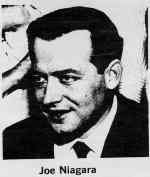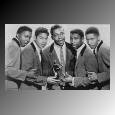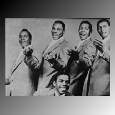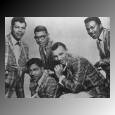Resume/Where is he now?
Philadelphia Stations:
WIBG/56-59
WFIL/62
WPEN
WCAU-AM
WCAU-FM
WDAS
WIFI
Other Stations:
KPOP/Los Angeles
Retired July 31, 1999
Died on June 4, 2004 of heart failure. He was 76.
Joe is in the Guiness Book of World Records 1980, for playing the most (over 500) consecutive different versions of Stardust.

Click on the car radio to hear Joe Niagara!
SIDE ONE (19:45):
Joe Niagra Theme
Susie Q - Dale Hawkins (2:12)
Muntz TV Commercial
Happy, Happy Birthday Baby - The Tuneweavers (2:17)
Gelatin-Plus & Rayco Commercial
School Days - Chuck Berry (2:35)
WIBG Jingle
A Thousand Miles Away - The Heartbeats (2:22)
The WIBG Weather Sound
Party Doll - Buddy Knox and the Rhythm Orchids (2:01)
1957 Ford Commercial
Goodnight Sweetheart - The Spaniels (2:44)
WIBG Station I.D.
SIDE TWO (19:45):
Little Darlin' - The Diamonds (2:05)
Maternity B.V.M. Hop Announcement
Over The Mountain, Across The Sea - Johnny & Joe (2:10)
WIBG Calling All Cars
Bony Moronie - Larry Williams (2:31)
WIBG Community Club Awards Promo
To The Aisle - The Five Satins (2:41)
WIBG Newstip Promo
Honeycomb - Jimmie Rodgers (2:12)
1957 Mercury Commercial
Long Lonely Nights - Lee Andrews & The Hearts (2:16)

"If you're ready, this rockin' bird will fly!"
The sound comes thundering into your teenaged head and it's 1957 in "Wibbageland," the greater Philadelphia area within the broadcast range of Joe Niagara and WIBG Radio. On this volume of the CRUISIN' series Joe sells you a Muntz TV and a '57 Mercury...he ad libs a rhymed patter ("You heard the word/From this rockin' bird...")...he plays all your favorite teenaged hits. The words come tumbling from his lips in phrasing and originality that will influence a decade of disc jockeys, affecting a generation of listeners.
If you were growing up near Brotherlylovesville in the Fifties, you had someone worth emulating in Wibbageland, you had a friend at "Radio 99" - someone who talked to you confidentially, but with a sense of excitement. In every way, Joe Niagara seemed right for rock radio.
He had been born in South Philly (birthplace of Mario Lanza and Joey Bishop) and had come to WIBG in 1947 following service in the Panama Canal Zone and a year at another of Philadelphia's dozen or so radio stations. Between 1947 and 1957 he had the highest rating of any radio personalities in the city.
Joe Niagara believed in rock and roll, or certainly seemed to. In '57 he actually seemed to be caught up in the revolution in sound that continued to sweep not just the country, but much of the world. In Japan a nineteen-year-old named Masaaki Hirao was being hailed as "the Elvis Presley of Japan's rockabilly set," and wearing not blue but yellow suede shoes. In Zakopane, Poland, blue-jeaned youngsters were belting what they called "ruck en rullye." In Boston a deejay offered six hairs from Presley's sideburns and in one week there were more than 18,000 contestants.
1957 was a year of accelerating excitement. The "cover" concept (whites singing songs originally recorded by blacks) was passe. Pacakage rock shows were racially mixed and packing houses everywhere. The 78 rpm record was dead. You held a fist-full of 45s now, hooking them over your thumb. And you hung knitted dice from the rear-view mirror of your chopped and lowered Forty-nine Ford. A radio announcer from upstate New York appeared in Philadelphia with a new idea in after-school television programming; he was called Dick Clark and it was called "American Bandstand." In October Little Richard threw $8,000 worth of jewelry into a river, said he was quitting show biz "to prove his faith in God," and enrolled in a seminary...and Elvis got his draft notice. But it didn't seem to slow the rush. Things were, as Elvis himself shouted, All Shook Up.
On another level in 1957, "The Bridge on the River Kwai" got the Oscar for best picture...French existentialist Albert Camus was the Nobel Prize winner in literature (this, in the year Jack Kerouac published the bible of American existentialists, "On the Road")...John Kennedy took the Pulitzer in biography for "Profiles in Courage"...Senator Strom Thurmond of South Carolina set a new filibuster record, keeping his mouth moving for twenty-four hours and eighteen minutes...and a small toy company in Los Angeles introduced the Barbie Doll.
One of the most popular blues-rock compositions of this year was Susie Q, a simple, no-frills, hard-edged song that was danceable as hell but offered little more than a repeated "Oh Susie Q" lyrically. Dale Hawkins was one of its composers and its singer. He was not to be confused with Screaming Jay Hawkins, another singer of the period, who rose from a coffin to scream, "I put a spell on you!"
Birthdays are important in rock and roll and Happy, Happy Birthday Baby by the Tuneweavers was but one of many anniversary-type songs on the pop charts in the Fifties. This was one of the tear-jerkers, with the lead singer asking an old flame to remember a birthday they once celebrated together, before there was "somebody new."
By '57, Chuck Berry had become one of the Old Reliables of rock. He'd been composing and performing basic but brilliant hits for three years now and this year one of his biggest was School Days, a song about what a drag they were. ("Soon as three o'clock rolls around/You finally lay your burden down.") As they said in 1957: Now you're talking my language, Chuck.
 A Thousand Miles Away was written by "Shep" Sheppard, who then had a group called the Heartbeats (a typically soppy Fifties name). It was all about a girl who was (you guessed it) just that far away. Later Shep would have another group, the Limelites, and rewrite the song, to sell it a million times again.
A Thousand Miles Away was written by "Shep" Sheppard, who then had a group called the Heartbeats (a typically soppy Fifties name). It was all about a girl who was (you guessed it) just that far away. Later Shep would have another group, the Limelites, and rewrite the song, to sell it a million times again.
In Texas, in the area adjoining New Mexico, is a stretch of flat cow country sometimes called "Tex-Mex" and it was here that several rock artists were born. Buddy Knox was second only to Buddy Holly in the brief, flashy history of Tex-Mex rock and certainly was its rockingest. His hit of 1957 was Party Doll, a song that was banned in many sections of the country because it was too sexy. Knox had so much fun singing it, made it such a boisterous, foot-stomping hit, the teenagers couldn't have cared less.
 From another section of the country (Chicago) came the Spaniels, who picked their name as a reaction to all the bird groups in R&B. At sock hops and American Legion Post dances on Friday nights their record of Goodnight Sweetheart became a standard, the record they played last so you could hold the girl of your choice real close. Close dancing was gone, real gone, in '57.
From another section of the country (Chicago) came the Spaniels, who picked their name as a reaction to all the bird groups in R&B. At sock hops and American Legion Post dances on Friday nights their record of Goodnight Sweetheart became a standard, the record they played last so you could hold the girl of your choice real close. Close dancing was gone, real gone, in '57.
Like the Mello Kings a year earlier, the Diamonds were a white group mistakenly thought to be black. They had been recording for Mercury for some time when their cover of a Gladiolas song, Little Darlin', was a hit. The Diamonds were part Canadian, part Californian...also part spoof, as they had been a progressive jazz group, turning to rock in parody. Once success set in, though, the Diamonds said to hell with jazz.
Johnny and Joe were one of the first of the duos to be so popular in the Fifties. (Another was Mickey and Sylvia.) Their gold record of the year: Over the Mountain, Across the Sea.
Larry Williams got his start playing a rattling New Orleans style piano with the band backing Lloyd Price, another R&B vocalist who made an early rock era cross-over to pop. It was while he was with Price (doubling as a valet) he was spotted and signed by Specialty Records, Price's label. Bony Maronie was one of several delightful novelty songs he wrote, each of which had a girl's name in the title. (Dizzie Miss Lizzie and Short Fat Fanny actually being takeoffs of other hits of the time, Lawdy Miss Clawdy and Long Tall Sally.)
 The Five Satins return to the CRUISIN' series with a second hit, To the Aisle. They continued to be the archetypal New York R&B group. A strong follow-up to In the Still of the Night, To the Aisle was one of many wedding songs so popular in the Fifties, the sort of tune young lovers liked best. Sloppy romanticism. With a "doo-wop" beat.
The Five Satins return to the CRUISIN' series with a second hit, To the Aisle. They continued to be the archetypal New York R&B group. A strong follow-up to In the Still of the Night, To the Aisle was one of many wedding songs so popular in the Fifties, the sort of tune young lovers liked best. Sloppy romanticism. With a "doo-wop" beat.
A different kind of beat came from Jimmie Rodgers, who began entertaining while serving four years in the Air Force (mostly in Southeast Asia) and then returned to his native Washington state to make the folk club scene. Someone from Roulette Records found him and suggested he go to New York for an audition, which he did. The peppy Honeycomb was the song the company executives picked for his first release. It became his first million-seller.
Loneliness always has been a popular theme for singers and songwriters and Long Lonely Nights was one of the big weepers of '57. Here it's done by the original group, Lee Andrews and the Hearts, former Philadelphia high school boys who came to Chess Records from a long string of charity appearances, where they'd sung spirituals.
Spirituals, gospel shouts, funky rhythm and blues, rockabilly, folk music, pop novelty...by 1957 it had come together; from Chicago, Philadelphia, New York, the Pacific Northwest, Tex-Mex...one amorphous, jumping, rhythmic, dymanic mass had formed. Pop radio.
- Jerry Hopkins.
CRUISIN' THE FIFTIES & SIXTIES: A History of Rock and Roll Radio. Conceived and recreated by: Ron Jacobs/Production and Research: Ellen Johnson and Jere Alan Brian/Engineering: John Horton/Art Direction: Paul Gruwell/Cover Art: Mike Royer/All selections are the original performances as released on the following labels: Checker: Dale Hawkins, The Tuneweavers/Chess: Chuck Berry, Johnny and Joe, Lee Andrews and the Hearts/End: The Spaniels/Herald: The Five Satins/Mercury: The Diamonds/Rama: The Heartbeats/Roulette: Buddy Knox, Jimmie Rodgers/Specialty: Larry Williams/Special thanks to: Jack Reynolds, WIBG Radio. Produced by Increase Records, a division of Watermark, Inc., Los Angeles, California. ©1970 Increase Records.

Back to the

index.

